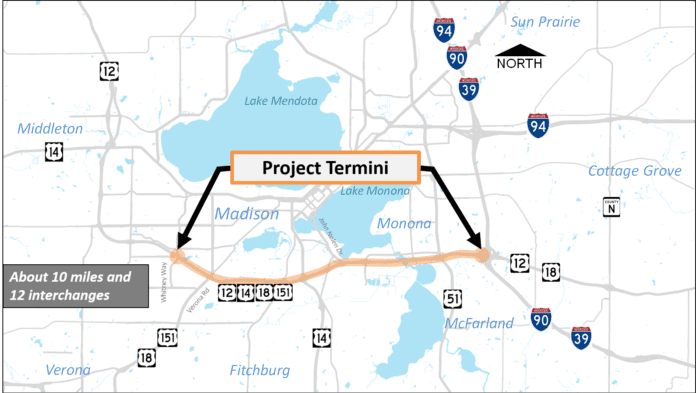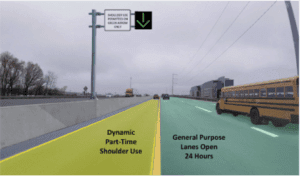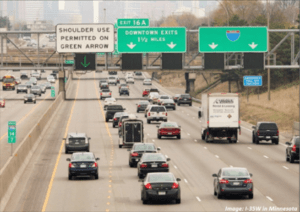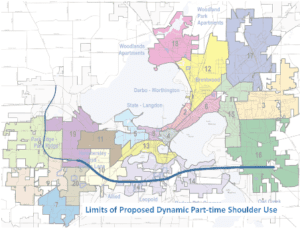Here’s the city staff report on Beltline shoulder usage that will be discussed at the Transportation Policy and Planning Board tonight at 5:00. I was surprised by the staff spin on the issue.
I would have thought they would have put more emphasis on the the statement that crashes are double the state average on the beltline given all the talk about Vision Zero. I’m also surprised they are making this into a downtown vs periphery districts issue. Maybe I’m wrong, but when I think of the beltline, I think of all the white people who are trying to escape the diversity of Madison. I don’t think that it is a racial equity issue because more people of color use the beltline. Maybe I’m wrong? It’s true, I live downtown and I don’t use the beltline that often. Anyways, here’s what the staff report says!
CITY STAFF REPORT
Beltline Dynamic Part‐time Shoulder Use
WisDOT, as part of the resurfacing of the Beltline, is proposing to restripe the Beltline and use the shoulders during rush hours for carrying traffic from Whitney Way to I‐39 (9 miles). Opening and closing of shoulders to traffic would occur through dynamic message signage occurring about every half‐mile. Many metropolitan areas in 17 states have implemented part‐time shoulder use. Midwest metro areas having implemented part time shoulder use include Minneapolis, Chicago, Columbus Ohio, and others. Studies and modeling indicate substantial congestion benefits with little to no safety impacts, partially due to better traffic flow reliability. The shoulders are monitored while in use, and are closed when the shoulders are needed for emergency response. The adjacent graphic illustrates the concept.
Disadvantages
- As with most roadway projects that increase motor vehicle capacity, this project could allow locational choices that can enable dispersed development and VMT.
- Emergency responders have expressed concern regarding the ability to access crash sites. Case studies do not confirm this concern if the shoulder lane is actively managed.
Considerations
Many Madison residents consider Beltline congestion a primary congestion concern. The Beltline is congested, and crashes are common (double the state average).
- While residents in central aldermanic districts may not frequently use the Beltline, it is a
primary roadway for aldermanic districts 1, 9, 10, 14, 16, 19, and 20. Because these areas have higher concentrations of persons of color, Beltline travel may be more frequent/important to these residents.
- The Beltline carries 130,000 vpd of east‐west traffic. This is more than East Washington, Johnson St, and Gorham St combined. Without dynamic shoulder running modeling indicates East & West Washington, University Ave, Johnson/Gorham, and Speedway would eventually see 5 to 12 percent more traffic by 2050.
- Part‐time shoulder use is more cost effective alternative than conventional expansion performed in Wausau, Fox Valley, and Milwaukee. WisDOT Southeast region has spent more than $500 million to provide capacity for I‐94, whereas use of the shoulders provides similar benefits for $30‐$40 million, with no right of way impact.
NEED MORE INFO?
I feel like I do! Here’s two websites I found with more info. The presentation and exhibits were useful in learning more.
- Here’s the DOT Video and info from their website
Dynamic Part Time Shoulder Use (DPTSU) – How it works
A preliminary design is being examined that would utilize the Beltline’s median (inside) shoulder lanes in each direction between I-39/90 and Whitney Way. In addition to improvements to the existing median shoulder and barrier wall – which would happen in each alternative – the design for part-time shoulder use would:
-
- Install dynamic overhead messaging to indicate when the lane is open.
- Display a green downward arrow when the shoulder lane is open, and a red “X” when closed.
- The lanes would be open for traffic during peak travel times, special events or incidents.
2. Even more information is available on the project specific website:
Overview
The Wisconsin Department of Transportation (WisDOT) is examining a range of alternatives to address deteriorating infrastructure needs in the pavement structure and median areas, and to address operational issues during weekday peak periods and unexpected congestion.
Potential Improvements
One alternative includes a resurfacing with drainage improvements and replacing deteriorated sections of the existing barrier wall.
The other alternative being considered involves all items included with the first, plus other upgrades to allow the Beltline median shoulders to be used as travel lanes. The shoulder travel lanes would open during peak periods to safely and efficiently improve travel reliability between Whitney Way and Interstate 39/90. The practice, known as part-time shoulder use, is currently in place in at least 17 states.
Part-time shoulder use is recognized as a safe, sustainable and reliable way to alleviate congestion. It allows vehicle traffic on paved shoulders during peak travel times. Changeable message signs would be used to indicate when the shoulder is available for use.
In addition to the mobility improvements, shoulder modifications:
-
- Minimize impacts to the environment
- Does not require real estate acquisition from adjacent properties
- Could be implemented as early as 2021
For more information on how Dynamic Part-Time Shoulder Use works, please click on “Video – How it works” located on the left side of the page.
Safety
-
- Experience in the U.S. to date has not identified major safety issues with part-time bus, static, or dynamic shoulder use that led to discontinuation.
- The best available predictive crash analysis tool was used for this project’s safety analysis.
- The relative analysis showed that with the activation of DPTSU, the number of predicted crashes is not anticipated to increase compared to a No-Build condition.
Reliability
-
- Travel time reliability, as well as the average amount of time needed to travel the Beltline during peak hours, are both projected to improve significantly with Dynamic Part-Time Shoulder Use.
- Median shoulder lanes would be available during the high-volume morning and afternoon travel periods to alleviate congestion and address existing safety concerns. During off-peak hours, the shoulder would be available for recovery and emergency stopping as usual.
- The shoulder lanes could also assist with traffic operations during special events or traffic incidents.
Sustainability
-
- The sustainability of the Madison Beltline is critical to south-central Wisconsin and a priority for WisDOT, which is focused on improving and prolonging the existing system while comprehensive long-term Beltline plans are evaluated.
- Dynamic Part-Time Shoulder Use is increasingly recognized as a way to optimize the performance of existing infrastructure and improve safety and reliability of the transportation system.
- Part-Time Shoulder Use would extend the remaining life of the Madison Beltline system while addressing existing safety and operational needs.
- Evaluations indicate the pavement life of the part-time shoulder lanes would function for at least 10-15 years following implementation.
- The modifications could be made with no real estate acquisitions from properties.
- Improvements to drainage, median barrier, pavement marking, spot shoulder widening and signage would be anticipated as part of implementation of dynamic part time shoulder use.
Schedule
-
- 2019-20 – Preliminary design
- July 24, 2019 – Public involvement meeting (PIM) to present Beltline alternatives
Project comments
WisDOT welcomes comments/suggestions. Please share your feedback on the alternatives, traffic, design, public outreach and long-term planning. Thank you for your interest and assistance with this project.
-
- Submit comments at PIMs and/or other public meetings.
- Send project comments via email to project staff.
- Via online comment/questionnaire.
Contact information
Brandon Lamers, P.E.
Project Supervisor
(608) 246-3852
brandon.lamers@dot.wi.gov
Steven Theisen
Communications Manager
(608) 884-1230
steven.theisen@dot.wi.gov
WHAT’S NEXT?
I dunno. I’m not sure what power the Transportation Policy and Planning Board has over this issue. It’s a state project. And it looks like the state was only planning on having the public input meeting last July.
UPDATE: On Wednesday night it look like the Madison Area Tranportation Planning Board (MPO) is taking the issue up and I think they are the real decision makers:
6:30 pm Madison Area Transportation Planning Board (MPO) Madison Water Utility 119 E Olin Ave, Room Conference A-B
-
- Resolution TPB No. 160 Approving Amendment #1 to the Regional Transportation Plan 2050 for the Madison Metropolitan Area to Add Beltline DPRTSU Project
This is what the state webpage on public input says:
Public involvement meetings (PIMs) and other meetings
Scheduled/future
-
- No meetings currently scheduled.
Past
-
- July 24, 2019 – Public involvement meeting (PIM) to present Beltline alternatives
Project comments
WisDOT welcomes comments/suggestions. Please share your feedback on the alternatives, traffic, design, public outreach and long-term planning. Thank you for your interest and assistance with this project.
- Submit comments at PIMs and/or other public meetings.
- Send project comments via email to project staff.
- Via online comment/questionnaire.
I submitted a question to the state to ask about decision timelines and process and will let you know if I find out anything!
Meanwhile, it will be interesting to see what the TPPB has to say tonight.









So the City is pulling the “persons of color” card to justify enabling more persons of little color to drive more and more. What B.S. One of the things this will do is further degrade air quality in the neighborhoods nearest the Beltline, where many person of color live, and give them more cases of asthma and other pollution-caused disease. That, and the obvious blindness to the City’s Climate Change Plan calling for reductions in CO2 emissions, makes for a pathetic overall regional transportation system.